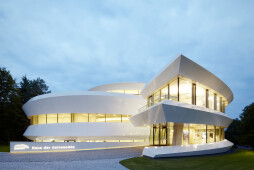The cornerstone for the renewed interest in astronomy in Germany was laid in the early 1960s. One of the reasons was the establishment of the European Southern Observatory (ESO) in the Chilean Atacama Desert. Many German research institutes were involved in this project. What began as the dream of leading European astronomers is now one of the most successful research institutes worldwide. Several Max Planck Institutes focusing on astronomy were set up at the same time. The Centre for Astronomy Education and Outreach in Heidelberg is considered the German hub for the work of the ESO. In October 2012, together with the employees of the Max Planck Institute for Astronomy, the centre celebrated the 50th anniversary of the charter being signed.
The Centre for Astronomy Education and Outreach is a unique institution. The research institute was initiated at the end of 2008 by the Max-Planck-Gesellschaft zur Förderung der Wissenschaften e.V. and the Klaus Tschira Stiftung gGmbH. The latter is a foundation which acted as the builder of the galaxy-shaped building, and the former runs the centre. The University of Heidelberg and city of Heidelberg are also partners. At the end of 2011, the Centre for Astronomy Education and Outreach moved into its own building on the Königstuhl near Heidelberg.
The Klaus Tschira Stiftung gGmbH commissioned the architects Bernhardt + Partner in Darmstadt. They were inspired by the Whirlpool Galaxy M51, which is located 28 million light years away. This resulted in a dynamic structure shaped like a spiral galaxy. The architects realised the moving appearance of the building using the dynamic arrangement of the comet-like arms and the effect of the three-dimensional curved façade. The new construction is divided into three areas. The Klaus Tschira Auditorium, which also contains a digital planetarium projection system, is located in the centre. Two building wings stretch nearly symmetrically around the core. A foyer and the ramp around the central planetarium join the levels. There are educational rooms, workshop rooms and offices in the spiral arms. When selecting the switch ranges, the Gira E2 and Gira push button sensor 3 were chosen. The Gira E2 switch line combines a puristic design with high quality. The line is made of shatter-proof thermoplastic with an elegant, slightly matt surface. The extraordinarily wide range of design variants matched to the Gira switch ranges is a particular advantage of the Gira push button sensor 3.
The white structure should spark the interest of the general public in astronomy and promote the exchange of knowledge. The centre conveys the fascination of astronomy to students, youth and all interested parties. Visitors gain insight into current research in the form of seminars, workshops and a series of lectures.
At the BAU 2013 trade fair in Munich, the architects Bernhardt + Partner received the Energy Efficiency Award 2013 for the Centre for Astronomy Education and Outreach. By presenting them this award, the jury acknowledged the excellent daylight concept and positive primary energy balance, as well as its outstanding architecture. The project is characterised by the successful realisation of the idea in a form.































